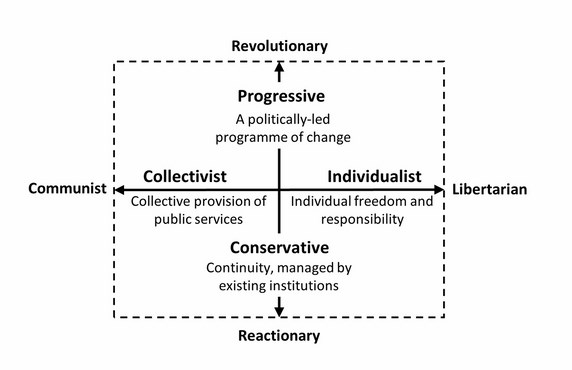6.2.1 Classifying Political Ideologies and Attitudes
Eliminating ambiguity in the naming of political ideologies and attitudes towards change, to describe different sets of values.
Some of the terms in common use have more than one meaning.
The word ‘liberalism’ is mostly avoided in this book because it has many meanings:
● Timothy Garton Ash, in The Future of Liberalism, defines it in ideological terms as having “a core commitment to individual liberty” and also as a political system offering “the best way for diverse people—and peoples—to live together well in conditions of freedom”.
● Bruce Buchan, in his essay Liberalism and fear of violence, showed that it cuts across both individualism and collectivism: “needing the state to ensure protection, but fearing the consequences of state power.”
● Paul Krugman, in his book Conscience of a Liberal, used the word to indicate his approval of President Roosevelt’s New Deal: which included taxing the rich, making it easier for workers to join unions and instituting a minimum wage, with what he described as positive effects.
● Some Americans equate liberalism with socialism, which many dislike. Pamela Paul’s article, Progressives Aren’t Liberal, describes the changes in the meaning of the word ‘liberal’ in American politics and offers a more traditional meaning:
“liberal values, many of them products of the Enlightenment, include individual liberty, freedom of speech, scientific inquiry, separation of church and state, due process, racial equality, women’s rights, human rights and democracy.
Unlike “classical liberals” (i.e., usually conservatives), liberals do not see government as the problem, but rather as a means to help the people it serves.”
When referring to political ideologies and attitudes, many people use the terms ‘right-wing’ and ‘left-wing’. Although this is broadly useful, it lacks precision:
● ‘Right-wing’ encompasses two meanings that are kept separate in this book: the word ‘conservative’ is used here to describe an approach to government which prefers to adhere to known practices and minimises intervention; the word ‘individualist’ is used to indicate a desire to maximise the liberty of the individual.
● ‘Left-wing’ is also replaced by two words in this book: ‘collectivist’ is used to define prioritising the common good, and the word ‘progressive’ is used to describe a desire to improve people’s lives by proactive politics (this is sometimes called ‘meliorism’).
Individualism and collectivism are opposing ideologies, with different attitudes towards freedom and responsibilities as described earlier (2.2). Conservatism and progressivism can have an ideological basis, but they can also be regarded as attitudes towards the introduction of change rather than as ideologies. Each of these four terms refers to a spectrum of opinion, varying from a mild tendency to an extreme.
These political ideologies and attitudes can be mapped diagrammatically, as shown below. The x axis represents degrees of individual liberty and the y axis represents appetite for change.
It is possible to occupy any position on this diagram. Chairman Mao’s Cultural Revolution was both revolutionary and communist, for example, whereas China’s government at the start of the 21st century could be categorised as conservative and less absolutely communist.
The central point of the diagram represents the midpoint of people’s political ideologies and attitudes. This varies by place and time:
● If mapping the whole world in the early 21st century, China would be below and to the left of centre, whereas George W. Bush’s America would be below and to the right on domestic policy.
● If mapping within America in the same period, the average Republican would be below and to the right of the centre and an average Democrat would be above and to the left.
Political programmes can be thought of as mapping a direction of movement away from the status quo, as in the example of Thatcherism – which moved Britain to the right during the 1980s.
Most people hold political beliefs that lie somewhere between the extremes of communism and libertarianism, and they vary in their appetite for change. People’s inherent diversity ensures that there will never be unanimity, and in practice people’s views change according to circumstances.
Each issue can be approached differently. There is no inconsistency in having a collectivist attitude towards public services whilst advocating the individualist policy of free trade, for example.
Differences between individualists and collectivists in economic policy (3.5.2), and in their moral viewpoints on politically-negotiated human rights (4.2.4), have been summarised in earlier chapters. In the Political Dimension, they profoundly disagree about the role of government. People also differ in their appetites for change.
These political ideologies and attitudes are described more `fully in the next four sections, followed by a section on steering a course between them and forming political parties.
This page is intended to form part of Edition 4 of the Patterns of Power series of books. An archived copy of it is held at https://www.patternsofpower.org/edition04/621b.htm.
